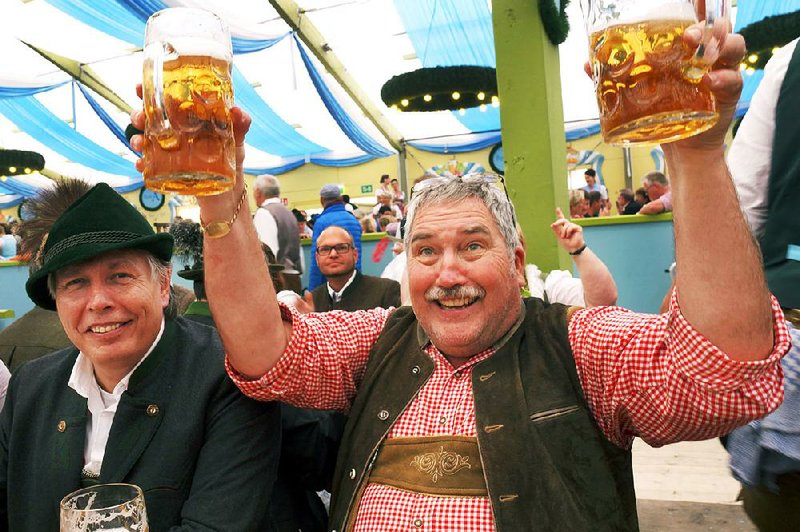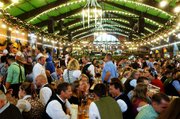Last year in Munich, I joined the planet's biggest kegger -- Oktoberfest. With my fellow revelers, we swayed our beer steins and toasted to "Gemuetlichkeit" (the cozy and convivial atmosphere). At the "whop" sound signaling the tapping of a classic old wooden keg, everyone knew they were in for a good fresh mug -- and another round of Oktoberfest cheer.
Oktoberfest dates to 1810, when the Bavarian king threw a grand public wedding reception for his son. It was such a hit that they decided to do it again the next year. And the next, and the next. More than 200 years later, it has become one of Europe's best-known festivals -- a beer-fueled frenzy of music, pretzels and amusement-park rides, with more than 7 million visitors consuming nearly 7 million liters of beer every year.
This year's Oktoberfest begins on Saturday and ends on Oct. 3 -- Germany's Unification Day. From the ceremonial tapping of the first keg at the festival's opening until its end, the huge fairground outside Munich's city center is a slap-happy world of sausages, fancy hats and maidens with flowers in their hair. For visitors, there's no better place to see (and join) Germans at play.
The Breweries Parade (on Sept. 17) brings a seemingly endless string of marching bands and troupes dressed in colorful traditional costumes. Leading the parade is the festival queen -- the "Munchner Kindl," a young woman on horseback, wearing the robe of a medieval monk. Massive, elaborately decorated draft horses clop by, pulling wagons filled with gigantic kegs of draft beer. Each of the city's main breweries enters a beer-theme float to entertain the crowds as they make their way from downtown Munich to the festival grounds -- a meadow called the "Wies'n."
Men sport lederhosen -- leather shorts with suspenders once worn by peasants working the fields -- accessorized with long stockings and a hat with a feather in it. Women wear dirndls -- single-piece dresses that include a skirt and low-cut blouse, covered with a bodice. These traditional Bavarian clothes are not mere party costumes, nor worn ironically. Locals treasure them, and break them out on special occasions.
Once the festival is in full swing, the atmosphere is infectious. Admission is free (you pay for food, rides and beer). Attendees can choose from around 15 main tents and a few smaller ones, all of which operate like pop-up beer halls. Filled with row after row of wooden tables and benches, the main tents are vast -- the largest holds 11,000 people. Some offer traditional oompah music, played by an ensemble of brass, woodwinds, accordion and drums. Other tents host rock bands. Some are family friendly, with kids' menus. In all the tents, beer is sloshed from morning until night, and everyone is convivial. Between beverages, people stroll the happy central promenade, giant gingerbread cookies in hand, enjoying the loud-and-proud celebration of all things Bavarian.
Munich's local breweries each have a tent. The famous ones (Augustiner and Hofbrau) can have long waiting lines and are the most touristy. At the Hacker-Pschorr hall, a barmaid with two painted German flags flanking her cleavage asked for my order. When I asked if I could get a half-liter ("eine Halbe"), the barmaid said, "Why don't you go home and come back when you're thirsty?" A full-size liter beer (about a quart, "eine Mass" in German) costs about $10, and the barmaids can carry up to 10 at once, as if the huge mugs were weightless. You can order a "Helles" (light), "Dunkles" (dark), or "Weissbier" ("white" wheat-based beer), or ask for a "Radler" (half lemon soda, half beer).
While it's filled with plenty of tourists, Oktoberfest is still very much a local scene. It's estimated that 90 percent of the attendees are Bavarians. The festival is busiest late and on weekends, but weekday afternoons and early evenings are a delight, when it's easier to find a spot inside a tent, and the grounds are filled with happy kids (Tuesdays are official family days).
These days, security is tight. A fence surrounds the festival grounds, and no large bags are allowed in. Each tent has a security officer, and there is a heavy police presence. In spite of all this, the atmosphere is still relaxed and fun. The security and organization are typical of German efficiency.
First-timers might find all the chaos a bit daunting. But Oktoberfest is, by its very nature, open and friendly. Take a seat at any table that can fit an extra rear end, dive into the conversation with a clink of the glass ("Prost!"), and immerse yourself in the boisterous and belching Bavarian atmosphere.
Travel on 09/10/2017

